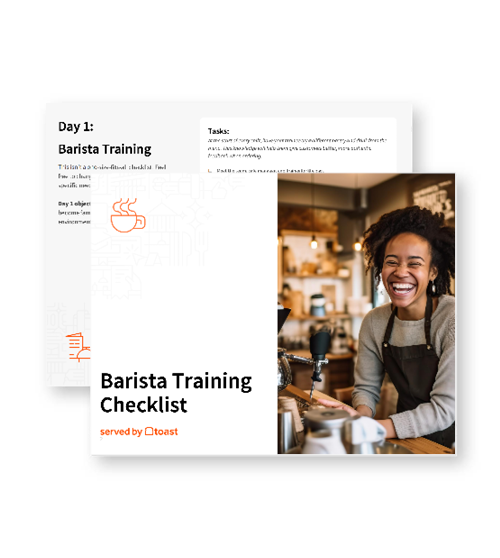
How Much Should Restaurants Pay Employees?
The best way to attract and retain employees is to offer competitive compensation. Here’s how to decide what to pay your staff.

Dahlia SnaidermanAuthor


Restaurant Labor Cost Calculator
Unlock the power of data-driven labor management with our free Restaurant Labor Cost Calculator. Stop guessing and start optimizing your staffing decisions today.
Get free downloadHow Much Should Restaurants Pay Employees?
According to The National Restaurant Association, the restaurant industry is expected to create 1.6 million new jobs in the U.S. by 2027. Though job opportunity growth is almost always a good thing, the rate of growth of the industry is outpacing the number of people who actually want to fill those jobs. In fact, the restaurant industry is growing at a rate that’s twice the rate of growth of the population.
What does this mean for you? We’ve got too many kitchens and not enough cooks (or servers or chefs or bussers or managers).
So how can you give your restaurant a competitive edge? You need to provide a best-in-class workplace environment by creating a supportive, enticing culture, providing career advancement opportunities and benefits to your employees, and offering a competitive compensation structure, whether it's hourly, hourly plus tips, or a salary.
It’s a lot, but it’s important.
How much you can and should pay your restaurant employees will be unique to your business, your margins, your legal wage obligations, and your philosophy on gratuities, but let's dive into some of the most common questions owners and operators ask when deciding how much to pay their employees.
Restaurant Labor Cost Calculator
Unlock the power of data-driven labor management with our free Restaurant Labor Cost Calculator. Stop guessing and start optimizing your staffing decisions today.

Top Questions Restaurateurs Ask About Wages
Who gets paid hourly and who gets paid a salary?
Traditionally, whether an employee is paid hourly or given a salary is determined by their role. Restaurant managers and chefs are often salaried, while most other front- and back-of-house employees are paid hourly. However, the lines start to blur when considering sous chefs and assistant GMs, who in some restaurants make salaries and in others make hourly wages.
While paying a sous chef or assistant GM a salary might seem like you’re giving them a step up on the career growth ladder, not everyone feels that way. Why? Earning a salary sometimes means getting paid less per hour for the amount of work that’s actually done, especially in the case of sous chefs or managers pulling 70-hour weeks.
In terms of your hourly staff, front-of-house restaurant employees are often considered tipped wage workers, meaning they’re paid a smaller, legally mandated base wage since the majority of their paycheck is comprised of earned gratuities (unless your restaurant has decided to employ a gratuity-free model).
Back-of-house employees are considered non-tipped wage hourly employees and are almost always paid a flat hourly rate. Though some states allow tipping out — which is when front-of-house employees share a percentage of total earned tips with back of house — it’s illegal in other states, because back-of-house workers don’t interact with customers.
This tipped wage vs. non-tipped wage status mainly comes into play during tax season and with regard to overtime regulations.
There are a number of factors that go into setting a salary or hourly wage. While federal and local labor laws set the fundamental parameters, you also have to take into account the responsibilities of the role in question as well as your operating costs, which dictate how much you can afford to pay.
Consider downloading Toast’s Restaurant Metrics Calculator to help you understand important operational metrics at a glance, like your COGS, prime cost, and labor cost. This will help you better understand what wages are feasible from a budgeting perspective.
When thinking about the responsibilities of each role and how much you should pay each one, consider the impact the role has on their life as a whole. The higher the stress, complexity, and experience associated with the role, the more you should pay.
How do I decide how much to pay my restaurant employees?
In an article for Entrepreneur, executive and entrepreneur coach Steven Robbins outlines a helpful process for setting salaries. He advises that you start by determining the highest salary you’re willing to pay by looking at whether the position can help drive growth and/or if it’s a support role that can streamline efficiency when it’s done well. Both matter, it’s just a factor of where it all fits into the big picture for the goals of your business.
After that, you flip the coin and consider the lowest amount you’re willing to pay.
This is where you can use online tools to determine the market rates for specific roles. Payscale gives you a top-down view by consolidating data across the restaurant industry as a whole (you can even request a free report), while Glassdoor and Salary.com get more specific by pulling salary ranges within a specific location.
It’s also a good idea to go low-tech and reach out to other business owners in your community to ask how much they pay their employees, though it's not guaranteed they’ll share their numbers with you.
And last but not least, consider the individual: A candidate with years of restaurant experience might be worth more to your team and your business than someone just joining the industry.
What wage and hour laws should I know?
It’s important to know that, depending on where your restaurant is located, there can be federal, state, and even local labor laws that determine minimum wage and overtime.
The Fair Labor Standards Act (FLSA) sets the federal (national) standard for minimum wage and overtime, which are $7.25 per hour and time and a half after 40 hours in any workweek. However, most states and several cities/metropolitan areas also have their own minimum wage and overtime laws, and, in most cases, employees are entitled to a higher rate of pay and additional overtime regulations, like time and half after eight hours worked in a day.
Take a look at the most current list of state level minimum wages for both tipped and non-tipped employees.
Regardless of your restaurant wage breakdown, when it comes time to pay your employees, you must stay compliant with local labor laws and regulations, and you must make sure you’re paying the correct amount, and always on time. Nothing will drive away your loyal employees faster than delayed paychecks or getting accidentally short changed due to a payroll error.
If you're using a restaurant payroll spreadsheet, punch cards, or pen and paper, payroll will likely eat up hours of your time and your pay period could be rife with costly errors — but if you take your restaurant payroll process online, you'll save time, increase accuracy, maintain compliance, and keep your employees happy when payday comes around.
What’s the tip credit?
The tip credit is another component of the FLSA that lets restaurants pay tipped employees a minimum cash wage (below the national minimum wage), while allowing for tipped income to make up the gap by either reaching or exceeding minimum wage. If in a shift, a tipped wage worker doesn’t make enough tips to earn what they’d earn making the non-tipped wage hourly rate, it’s the employer’s responsibility to pay that employee the difference.
Per the U.S. Department of Labor, the current federal minimum cash wage is $2.13 with a maximum tip credit of $5.12 per hour, which combined equals $7.25. Employers using the tip credit must be able to prove the employee earned at least minimum wage through a combination of the minimum cash wage and any tip credit contributed by the employer.
As with minimum wage, many states and several cities have their own legislation in regards to the tip credit. Often, if the minimum wage is higher, the minimum cash wage and tip credit will also be higher. Seven states – Alaska, California, Minnesota, Montana, Nevada, Oregon, and Washington – don’t allow the use of a tip credit at all. Instead, they require that tipped employees be paid minimum wage plus tips.
With the ongoing debate over the federally recognized minimum wage, restaurant owners and operators need to stay up to date on the legally recognized minimum wage for tipped wage and non-tipped wage workers in their area by regularly checking the Department of Labor's website.
Does paying above minimum wage make a difference?
In short, yes.
Starting with the fast-food industry as an example, Sonic, McDonald’s, and Starbucks pay workers at corporate-owned stores more in order to gain a competitive advantage by being seen as more attractive and desirable employers.
Back in 2015, McDonald's found that by offering workers $1 above minimum wage, they saw lower crew turnover and higher customer satisfaction ratings.
In-N-Out Burger is also known for paying well above minimum wage, and they’re also one of the most recommended restaurants in the United States. Along with strong word-of-mouth among customers, In-N-Out is also rated highly as a top place to work.
In fact, a survey of 80 senior business leaders showed that 95% of survey respondents feel company culture affects consumer purchase decisions: Businesses ranked with the worst customer experiences are also considered the worst places to work. It’s all connected.
Finally, a 2017 Harvard Business School study found that raising minimum wage actually knocked out the weaker performers in restaurant space, while restaurants with high approval ratings showed no impact from the wage increase.
What does it cost me if an employee quits?
According to Cornell's School of Hotel Administration, the cost of turning one hourly employee can be as high as $5,864. If you consider how much it costs to train a replacement, losing an employee costs an employer 16% of the former employee’s total first-year compensation. If this person was paid minimum wage, the cost is pegged at nearly $2,500.
If the job you’re replacing is a high-complexity role, the cost can go up to $10,000.
What else can I offer on top of competitive restaurant wages?
Though compensation is an important factor for existing and prospective employees when deciding to take a job or stay in their role at a restaurant, today's job seekers are looking for more than just cash. They’re more interested in companies that offer career advancement opportunities, job perks, and employee benefits that make their lives easier.
Whatever you offer, make it clear in your job posting, interview, offer letter, and contract. Here’s an example restaurant job offer letter you can use.
Fostering growth starts on day one with new hire onboarding. Consistently training your restaurant staff from the moment they join your team will not only improve the overall quality of your guest experience, it will breed loyalty among your staff who recognize and appreciate your willingness to help them grow and get to the next level. Employees today want to work for companies that care about their personal and professional growth.
To help you evaluate which employee benefits you could bring into your compensation model, we've put together a list of impactful non-traditional employee benefits to help you stand out to job seekers and retain the staff you already have.
Beyond benefits, you want to create a culture that makes your restaurant employees excited to come to work everyday. Millennials, for example, favor supporting values-based organizations. Put some time into developing your restaurant core values, as well as your mission, vision, and purpose to attract them to open spots on staff or entice them to stick around.
Recognition and appreciation also go a long way when it comes to improving your restaurant's employee retention. In a post for InCredibly, service industry consultant Charles D’Amico explains, “If you have an A+ employee who can only work Tuesday and Thursday nights, that means there’s two shifts a week when you don’t have to worry about operations. It’s counterintuitive to your business to say that you’d rather have C-grade employees working full-time than an all-star team of part-timers.” Recognize the all-stars on staff with bonuses, free meals, a section of their choice, or additional time off.
There you have it, the top questions owners and operators ask when it comes to deciding how much restaurants should pay their employees. How you choose to approach payroll, wages, and compensation should be unique to your restaurant, your employment philosophy, and your budget, but ask around and make sure you’re paying a little more than your neighbors to stand out of the crowd as an awesome employer.
Related Resources
Is this article helpful?
DISCLAIMER: This information is provided for general informational purposes only, and publication does not constitute an endorsement. Toast does not warrant the accuracy or completeness of any information, text, graphics, links, or other items contained within this content. Toast does not guarantee you will achieve any specific results if you follow any advice herein. It may be advisable for you to consult with a professional such as a lawyer, accountant, or business advisor for advice specific to your situation.
Read More
Subscribe to On the Line
Sign up to get industry intel, advice, tools, and honest takes from real people tackling their restaurants’ greatest challenges.






